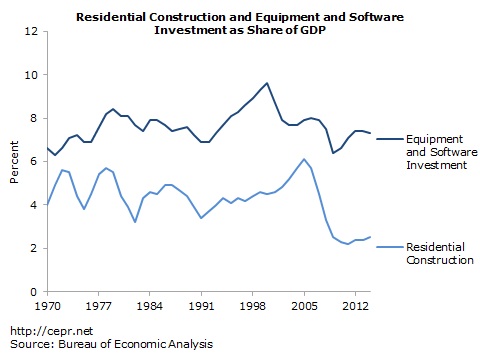October 26, 2012
October 26, 2012 (GDP Byte)
By Dean Baker
GDP growth accelerated modestly in the third quarter to a 2.0 percent annual rate, driven by an 8.5 percent growth rate in durable good purchases and a 13.0 percent rise in defense spending. A 14.4 percent rise in housing investment also boosted growth in the quarter.
The increase in durable goods sales followed a modest drop in the second quarter. Interestingly most of the growth in durables was in the recreational goods and vehicles category, which expanded at a 13.4 percent annual rate. These would presumably be viewed largely as non-essential expenditures.
Spending on services continued to grow slowly, expanding at just a 0.8 percent annual rate. A main factor was the second consecutive quarterly drop in real health care spending. The only prior periods in which real spending declined in consecutive quarters were from the third quarter of 2009 to the first quarter of 2010 and in the 1981-1982 recession. Nominal health care spending increased at just a 0.5 percent annual rate, the slowest growth since 1965. While the weakness of the economy is almost certainly a factor in slowing growth, it is likely that we are seeing evidence of a slower growth path for spending. The implications of this for the economy and the budget debates will be enormous.
Investment was extraordinarily weak in the quarter, shrinking at a 1.3 percent annual rate. Structure investment fell at a 4.4 percent rate, while investment in equipment and software was flat. The drop in structure investment was largely driven by a sharp falloff in construction of power facilities. It is likely that both categories of investment are being held back by uncertainty at the moment. With the outcome of the election in doubt, there are many tax and regulatory decisions that could affect the profitability of various investments.
Note that this is not quite the type of uncertainty that is sometimes raised as a concern. The issue is not fear of government regulation or taxes, the issue is the uncertainty about whether the policies will change dependent on who ends up in the White House. Even with the weakness in the third quarter, investment in equipment and software is pretty much in line with its long-term trend measured as a share of GDP. The notion that government policy will lead to an investment boom that will qualitatively change the path of the recovery is not plausible.
Residential construction continued to grow at a healthy pace, adding 0.33 percentage points to growth in the quarter. This pace of growth is likely to continue through 2013 and into 2014, until it returns to its normal share of output. Trade was a net negative in the quarter, subtracting 0.18 percentage points from growth. Exports fell at a 1.6 percent annual rate, and imports fell at a 0.2 percent rate.
Most categories of government spending were flat, but defense spending surged after having fallen the prior three quarters. The timing of defense spending is always erratic and this increase is unlikely to be repeated. Inventories subtracted 0.12 percentage points from growth. The current growth rate is unusually slow, meaning the sector will probably be a source of growth in future quarters.
The saving rate for the quarter was just 3.7 percent. This is below the saving rates of 2009-2011, and well below the saving rates in the years prior to the stock and housing bubbles. It is difficult to envision the saving rate falling much further. If anything, it is surprising that consumers are spending as much as they are, especially considering the threats in Washington to cut Social Security and Medicare, which would be expected to prompt more saving.
There is little in this report to suggest much basis for a qualitative pick-up in growth any time soon. The uncertainties surrounding tax and regulatory policy will clear up after the election, which will lead to more investment, but there is no other sector that is likely to see a substantial uptick any time soon. Of course the deficit reduction that will take place in 2013 will be a damper on growth. It is unlikely that we will be able to sustain growth much above the economy’s 2.5 percent potential.







